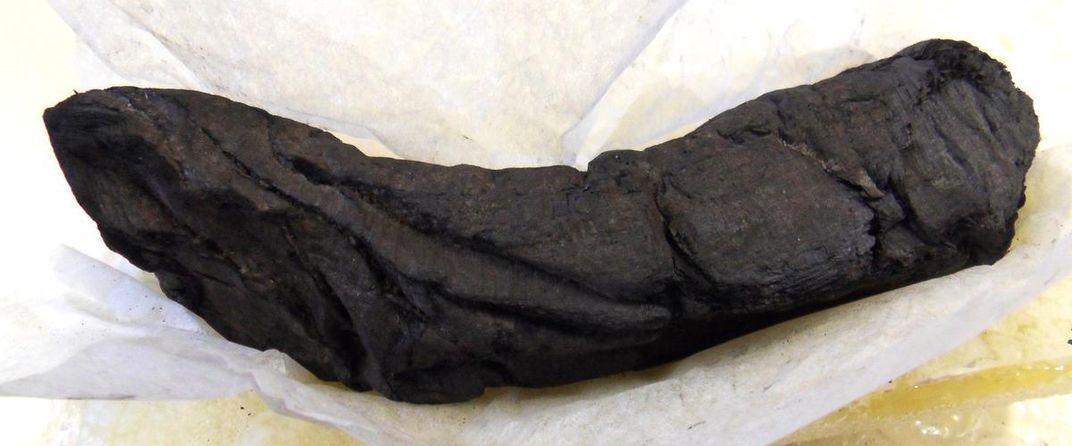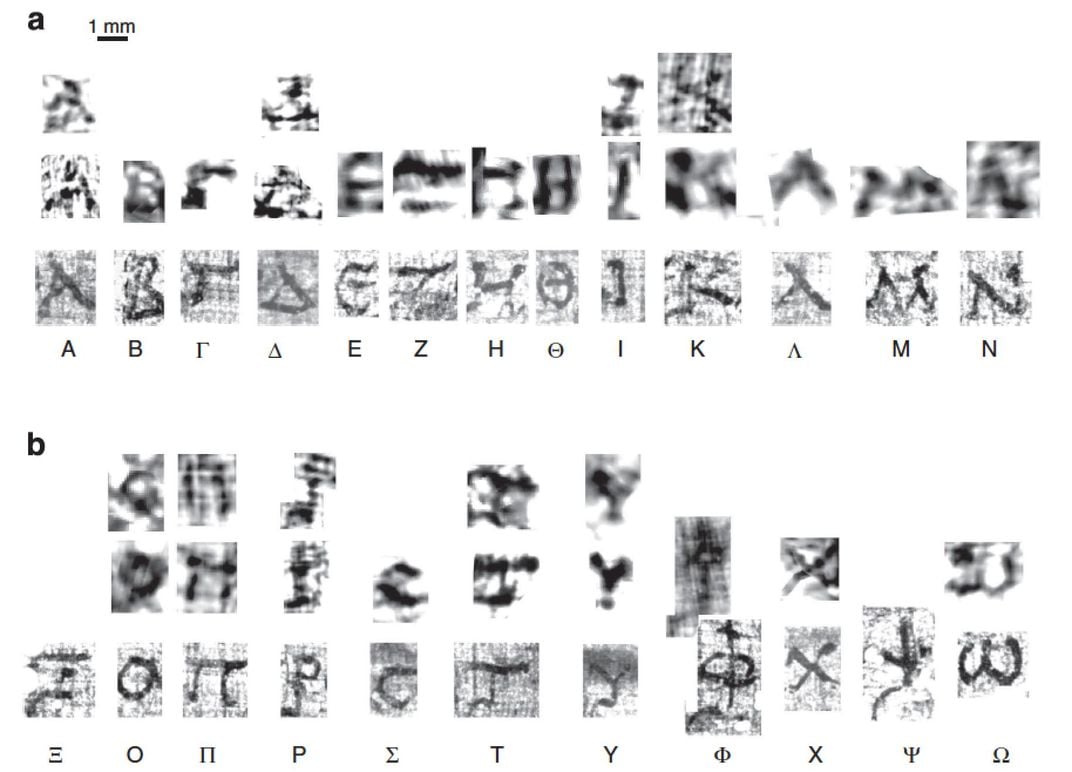Ancient Scrolls Blackened by Vesuvius Are Readable at Last
X-ray scans can just tease out letters on the warped documents from a library at Herculaneum
/https://tf-cmsv2-smithsonianmag-media.s3.amazonaws.com/filer/d7/d5/d7d527b1-acd5-4d50-a729-6241f4d75f32/scoll-close.jpg)
The lavish villa sat overlooking the Bay of Naples, offering bright ocean views to the well-heeled Romans who came from across the empire to study. The estate's library was stocked with texts by prominent thinkers of the day, in particular a wealth of volumes by the philosopher Philodemus, an instructor of the poet Virgil.
But the seaside library also sat in the shadow of a volcano that was about to make terrible history.
The 79 A.D. eruption of Mount Vesuvius is most famous for burying Pompeii, spectacularly preserving many artifacts—and residents—in that once bustling town south of Naples. The tumbling clouds of ash also entombed the nearby resort of Herculaneum, which is filled with its own wonders. During excavations there in 1752, diggers found a villa containing bundles of rolled scrolls, carbonized by the intense heat of the pyroclastic flows and preserved under layers of cement-like rock. Further digs showed that the scrolls were part of an extensive library, earning the structure the name Villa of the Papyri.
Blackened and warped by the volcanic event, the roughly 1,800 scrolls found so far have been a challenge to read. Some could be mechanically unrolled, but hundreds remain too fragile to make the attempt, looking like nothing more than clubs of charcoal. Now, more than 200 years later, archaeologists examining two of the scrolls have found a way to peer inside them with x-rays and read text that has been lost since antiquity.
"Anybody who focuses on the ancient world is always going to be excited to get even one paragraph, one chapter, more," says Roger Macfarlane, a classicist at Brigham Young University in Utah. "The prospect of getting hundreds of books more is staggering."
Most of the scrolls that have been unwrapped so far are Epicurean philosophical texts written by Philodemus—prose and poetry that had been lost to modern scholars until the library was found. Epicurus was a Greek philosopher who developed a school of thought in the third century B.C. that promoted pleasure as the main goal of life, but in the form of living modestly, foregoing fear of the afterlife and learning about the natural world. Born in the first century B.C. in what is now Jordan, Philodemus studied at the Epicurean school in Athens and became a prominent teacher and interpreter of the philosopher's ideas.
Modern scholars debate whether the scrolls were part of Philodemus' personal collection dating to his time period, or whether they were mostly copies made in the first century A.D. Figuring out their exact origins will be no small feat—in addition to the volcano, mechanical or chemical techniques for opening the scrolls did their share of damage, sometimes breaking the delicate objects into fragments or destroying them outright. And once a page was unveiled, readability suffered.
"Ironically, when someone opened up a scroll, they would write on a separate sheet what they could read, like a facsimile, and the original ink, once exposed to air, would start to fade," says Brent Seales, a computer scientist at the University of Kentucky who specializes in digital imaging. What's more, the brute-force techniques usually left some pages stuck together, trapping hidden layers and their precious contents.
From 2007 to 2012, Seales collaborated with Daniel Delattre at the French National Center for Scientific Research in Paris on a project to scan scrolls in the collections of the Institut de France—former treasures of Napoleon Bonaparte, who received them as a gift from the King of Naples in 1802. Micro-CT scans of two rolled scrolls revealed their interior structure—a mass of delicate whorls akin to a fingerprint. From that data the team estimated that the scrolls would be between 36 and 49 feet long if they could be fully unwound. But those scans weren't sensitive enough to detect any lettering.
The trouble is that papyri at the time were written using a carbon-based ink, making it especially hard to digitally tease out the words on the carbonized scrolls. Traditional methods like CT scans blast a target with x-rays and look for patterns created as different materials absorb the radiation—this works very well when scanning for dense bone inside soft tissue (or for peering inside a famous violin), but the method fails at discerning carbon ink on blackened scrolls.

Now a team led by Vito Mocella of the Italian National Research Council has shown for the first time that it is possible to see letters in rolled scrolls using a twist on CT scanning called x-ray phase-contrast tomography, or XPCT. Mocella, Delattre and their colleagues obtained permission to take a fragment from an opened scroll and a whole rolled scroll from the Paris institute to the European Synchrotron in Grenoble. The particle collider was able to produce the high-energy beam of x-rays needed for the scans.
Rather than looking for absorption patterns, XPCT captures changes in the phase of the x-rays. The waves of x-rays move at different speeds as they pass through materials of various density. In medical imaging, rays moving through an air-filled organ like a lung travel faster then those penetrating thick muscle, creating contrast in the resulting images. Crucially, the carbon-based ink on the scrolls didn't soak into the papyrus—it sits on top of the fibers. The microscopic relief of a letter on the page proved to be just enough to create a noticeable phase contrast.
Reporting today in the journal Nature Communications, Mocella and his team show that they were able to make out two previously unreadable sequences of capital letters from a hidden layer of the unrolled scroll fragment. The team interprets them as Greek words: ΠΙΠΤΟΙΕ, meaning "would fall", and ΕΙΠΟΙ, meaning "would say". Even more exciting for scholars, the team was able to pick out writing on the still-rolled scroll, eventually finding all 24 letters of the Greek alphabet at various points on the tightly bundled document.

Even though the current scans are mostly a proof of concept, the work suggests that there will soon be a way to read the full works on the rolled scrolls, the team says. "We plan to improve the technique," says Mocella. "Next spring we have an allowance to spend more time at the Grenoble synchrotron, where we can test a number of approaches and try to discern the exact chemical composition of the ink. That will help us improve the energy setting of the beam for our scan."
"With the text now accessible by virtue of specialized images, we have the prospect of going inside the rolled scrolls, and that's really exciting," says Macfarlane. Seales agrees: "Their work is absolutely crucial, and I am delighted to see a way forward using phase contrast."
Seales is currently working on ways to help make sense of future scans. With support from the National Science Foundation and Google, Seales is developing software that can sort through the jumbled letters and figure out where they belong on the scroll. The program should be able to lump letters into words and fit words into passages. "It turns out there are grains of sand sprinkled all the way through the scrolls," says Seales. "You can see them twinkling in the scans, and that constellation is fixed." Using the sand grains like guide stars, the finished software should be able to orient the letters on the whorled pages and line up multiple scans to verify the imagery.
The projects offer hope for further excavations of the Herculaneum library. "They stopped excavating at some point for various reasons, and one was, Why should we keep pulling things out if they are so hard to read?" says Seales. But many believe there is a lower "wing" of the villa's collection still buried, and it may contain more 1st-century Latin texts, perhaps even early Christian writings that would offer new clues to Biblical times.
"Statistically speaking, if you open up a new scroll of papyrus from Herculaneum, it's most likely going to be a text from Philodemus," says MacFarlane. "But I'm more interested in the Latin ones, so I would not be unhappy at all to get more Latin texts that are not all banged up."
For Mocella, being able to read even one more scroll is crucial for understanding the library and the workings of a classical school of philosophy. "Regardless of the individual text, the library is a unique cultural treasure, as it is the only ancient library to survive almost entire together with its books," he says. "It is the library as whole that confers the status of exceptionality."
The scanning method could also be useful for texts beyond the Roman world, says Seales. Medieval books often cannibalized older texts to use as binding, and scans could help uncover interesting tidbits without ruining the preserved works. Also, letters and documents from the ill-fated Franklin expedition to the Northwest Passage in the 19th century have been recovered but are proving difficult to open without doing damage. "All that material could benefit from non-invasive treatment," says Seales.

